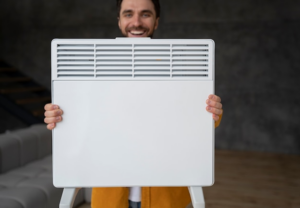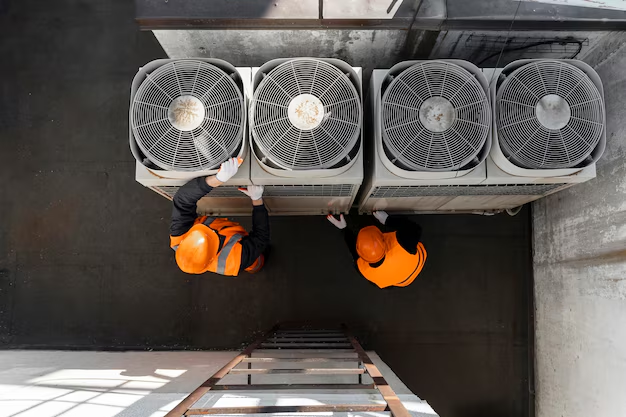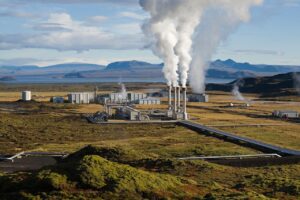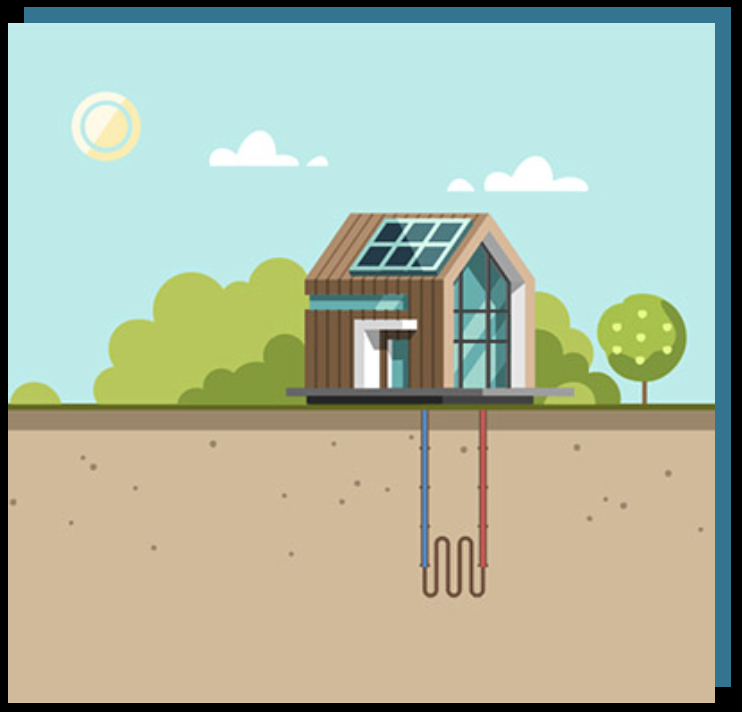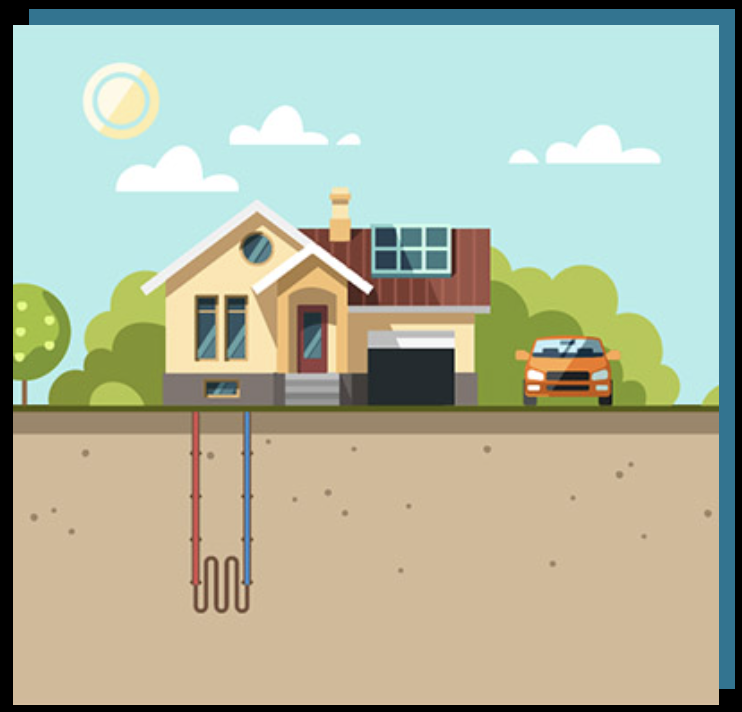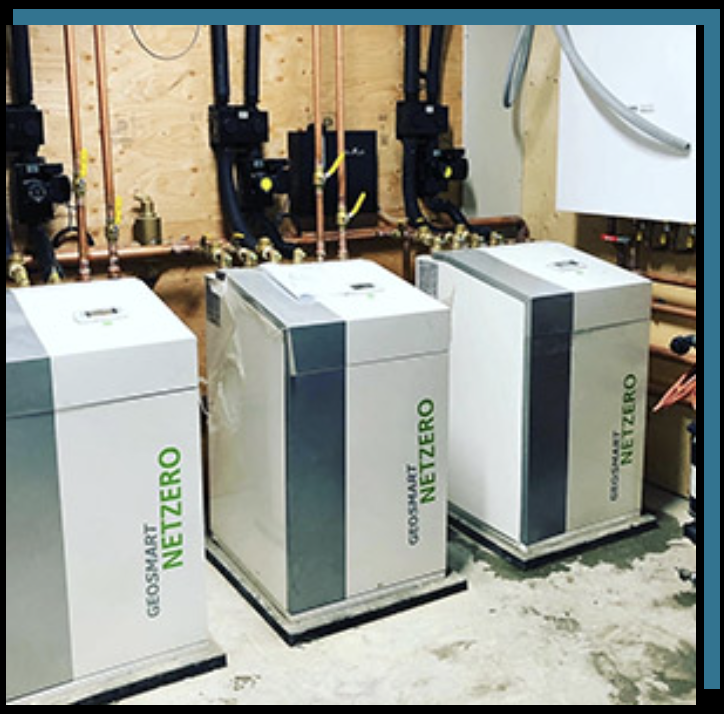Homeowners looking to build or purchase new homes take everything into account. Initial costs, time to completion, systems maintenance, and monthly operating costs are just a few. More and more, homeowners want to know how green their new home can be. As one of the most significant ways to reduce a home’s carbon footprint, geothermal HVAC systems are on top of many homeowner lists. To learn more about installing geothermal heating and cooling for your home or business read on!
Discover how geothermal heating and cooling fits your needs.

When a customer approaches a homebuilder, they have plenty of questions about geothermal beyond it being a green solution. As a home builder in Alberta, you want to answer all the questions they have. But what are those questions and more importantly, what are the answers? Here are a number of questions frequently asked by people considering installing geothermal heating and cooling system in their new home:
1. What makes geothermal so much better than other systems?
Geothermal heating and cooling systems are an active way for a homeowner to reduce their carbon footprint. These systems don’t burn or consume fossil fuels so they are cleaner, and have a positive impact on efforts to reduce greenhouse gasses (GHG). That being said, efficiency, stability, and lower operating costs are also very important advantages to a geothermal heating and cooling system.
In addition, many people don’t realize the cooling benefits in summer months of a geothermal heating and cooling system. While conventional air conditioners require increased power consumption due to forcing the hot air from inside your home, to the outside, geothermal systems are several hundred times more efficient. The refrigeration circuit draws lower temperatures from the earth with minimal effort. And the more you cool, the more heat you put back into the earth, rather than into the atmosphere. Consider it beneficial to cool, and more comfortable!
2. Are there different types of geothermal systems?
Yes. Ground Source Heat Pumps (GSHPs) can differ in the way they are configured. While the equipment inside the home is usually at least similar between installations (and dependent on size), the heat/cooling transfer system–the piping underground–can be configured in different ways. Piping can be installed vertically, where the pipes go straight down into the ground. A horizontal system (often referred to as a slinky installation) buries looped piping in horizontal trenches. When a pond, lake, or other body of water is nearby and available, the piping system lies on the bottom. These are all considered “closed loop” systems as the pipes are filled with a solution that travels back and forth through the system.
An open loop system uses groundwater pumped from a well, making one circuit through the system before being dumped back into the ground.
3. Will I lose my entire yard when the pipes are installed?
No. It depends on a lot of factors, including available space and the geology underneath. Vertical piping can be installed in a space as small as 10 to 15 feet across.
4. Is maintenance more involved than a gas or electric furnace?
Actually, it’s less for geothermal systems. There are fewer moving parts in a GSHP. Once installed, the piping does not require maintenance. The above-ground portions of the system require maintenance on a less frequent basis than traditional systems. Because a GSHP moves more air through the space (which is a good thing), filters should be cleaned or replaced more often. It is recommended that home or business owners use a reputable HVAC company to provide an annual service call.
5. Does it cost more than other HVAC systems?
To answer that question, let’s consider all costs for a geothermal system. The initial cost for a geothermal system can be more than the less efficient alternatives. Operating and maintenance costs are significantly lower on a monthly and annual basis. Compared to other renewable energy systems, geothermal has a potential payback of 7-10 years, if not less. As gas prices rise, this payback period could be even shorter. If the system is paired with a solar power system, operational costs could be reduced (not to mention reducing the carbon footprint even further).
6. Does installing geothermal heating and cooling cost less to operate?
Yes. Since it doesn’t burn or consume fossil fuels like gas or heating oil, those costs are eliminated. Because these systems use heat energy from the earth, they use less electricity to condition the air and move it around your home. That means, in most cases, the monthly utility bill for heating and cooling is lower. Geothermal units are as much as 400% more efficient than other types of HVAC units, so there is a significant cost reduction because of efficiency.
As far as maintenance costs are concerned, there are less stringent requirements than with some alternative systems. Since there are fewer moving parts, there are fewer pieces that wear out over time and need to be replaced. For those systems with underground piping, that part of the system will last for decades.
7. How can the same system heat AND cool my home?
A bit counterintuitive, isn’t it? Traditional systems can have a split fuel source such as natural gas for heating and electricity for cooling. In all-electric systems, the heating portion of the system uses completely different components than the air conditioning. Geothermal systems, especially a GSHP removes heat from the home and stores it underground in the summer. The same system extracts that heat back from the ground to heat the home in the winter.
8. Aren’t geothermal systems noisy?
Because they don’t have the outdoor condenser unit (the noisy box outside the home), that noise is eliminated. The system itself is normally tucked away in a furnace or mechanical room, and noises are significantly reduced. Some GSHP systems have additional noise reduction technology to add to the comfort.
9. Does it take a long time to install?
Installing geothermal heating and cooling systems is similar to other systems, so that portion of the installation period is similar. For the underground piping, that depends on what type of piping will be installed, but in most cases only takes a few days.
10. I live in the city/on an acreage. Is installing geothermal heating and cooling right for me?
Because of all the ground loop options available, space is not an issue for most property owners. In the city or suburbs with limited space, vertical piping can be used to reduce space requirements. In areas where more space is available, horizontal looping can be utilized. If there is a pond close by, the types and configurations of the underground portion of the system could take advantage of that proximity.
Bonus Question #1: I know there are incentives but I have no idea what I would be eligible for and how I would apply.
You really don’t have to know more than they exist. The partner you choose to purchase the system from knows all of the applicable government and utility incentives and will walk you through the application process of designing and installing geothermal heating and cooling systems for your property.
Bonus Question #2: What happens if I sell my house? Does the geothermal system add value?
Installing geothermal heating and cooling can indeed add value to your home. These systems are highly sought after for their efficiency, cost-effectiveness, and environmental benefits. Homes with geothermal systems may attract buyers looking for long-term savings and eco-friendly features, potentially leading to a higher resale value. However, the exact impact on property value can vary based on the local real estate market and buyer awareness of geothermal technology benefits.
The field of geothermal energy and geothermal installation is continuously evolving, with ongoing research and technological advancements aiming to improve efficiency, reduce costs, and make systems easier to install. Future developments might include improved heat pump technology, more efficient drilling techniques, and better materials that enhance the system’s longevity and performance. Innovations could also focus on making geothermal systems even more compact and adaptable to different types of properties.
Bonus Question #3 What Are Some Key Environmental Benefits for Installing Geothermal Heating And Cooling
Installing geothermal systems offer significant environmental advantages because they operate with remarkable efficiency, often achieving 300% to 600% efficiency even during cold winter nights. This high efficiency translates to a substantial reduction in greenhouse gas emissions as less electricity is required for operation, much of which is generated from carbon-intensive sources.
The installation and operation of geothermal systems have a relatively low impact on the environment. Unlike air-source heat pumps, geothermal units do not contribute to outdoor noise pollution, as their operational components are buried underground or housed within structures. Moreover, these systems do not emit pollutants on-site, which helps in maintaining cleaner local air quality.
Summary For Installing Geothermal Heating And Cooling
Homeowners, builders, or developers, we can help guide you to apply for incentive programs. Envirotech Geothermal proudly serves the greater Edmonton and Calgary areas including Lakeland, Canmore, Devon, Grande Prairie, Red Deer, and Rockyview by helping homeowners and builders to discover the benefits and features of geothermal heating and cooling. Contact us today to learn how you can save up to 70% on your heating and cooling bills by utilizing geothermal heating and cooling in your home. Call us at 1-866-Go-Heats or request a Geothermal Consultation for more information.

